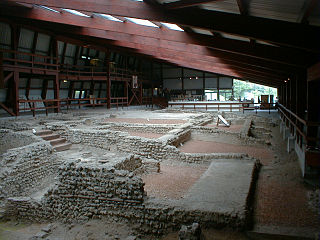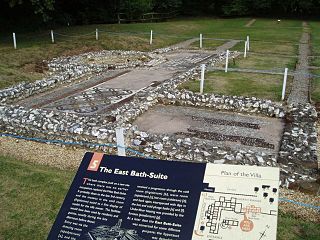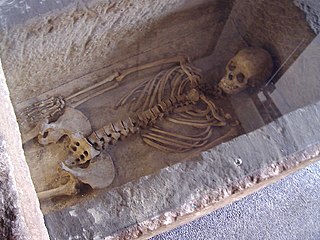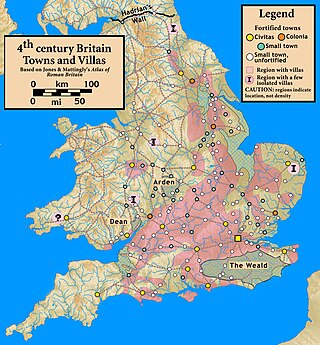
Lullingstone Roman Villa is a villa built during the Roman occupation of Britain, situated in Lullingstone near the village of Eynsford in Kent, south-eastern England. The villa is located in the Darent Valley, along with six others, including those at Crofton, Crayford and Dartford. Constructed in the 1st century, perhaps around 80–90 AD, the house was repeatedly expanded and occupied until it was destroyed by fire in the 4th or 5th century. The villa was occupied over various periods within the Romano-British period, but after its destruction, it is only thought to have been reoccupied during the medieval period. The occupants were most likely wealthy Romans or native Britons who had adopted Roman customs.

Fishbourne Roman Palace is in the village of Fishbourne, Chichester in West Sussex. The palace is the largest Roman residence north of the Alps, and has an unusually early date of 75 AD, around thirty years after the Roman conquest of Britain.

Winterton is a town in North Lincolnshire, England, 5 miles (8 km) north-east of Scunthorpe. The 2021 census found 4,765 inhabitants living in the town. Winterton is located near the banks of the Humber and is 8 miles (13 km) south-west of the Humber Bridge which can be seen from many parts of the town.

Sabratha, in the Zawiya District of Libya, was the westernmost of the ancient "three cities" of Roman Tripolis, alongside Oea and Leptis Magna. From 2001 to 2007 it was the capital of the former Sabratha wa Sorman District. It lies on the Mediterranean coast about 70 km (43 mi) west of modern Tripoli. The extant archaeological site was inscribed as a UNESCO World Heritage Site in 1982.

The Villa Romana del Casale is a large and elaborate Roman villa or palace located about 3 km from the town of Piazza Armerina, Sicily. Excavations have revealed one of the richest, largest, and most varied collections of Roman mosaics in the world, for which the site has been designated as a UNESCO World Heritage Site. The villa and artwork contained within date to the early 4th century AD.

Chedworth Roman Villa is located near Chedworth, Gloucestershire, England and is a scheduled monument. It is one of the largest and most elaborate Roman villas so far discovered in Britain and one with the latest occupation beyond the Roman period. The villa was built in phases from the early 2nd century to the 5th century, with the 4th-century construction transforming the building into an elite dwelling arranged around three sides of a courtyard. The 4th-century building included a heated and furnished west wing containing a dining-room (triclinium) with a fine mosaic floor, as well as two separate bathing suites: one for damp-heat and one for dry-heat.

Great Witcombe Roman Villa was a villa built during the Roman occupation of Britain. It is located on a hillside at Great Witcombe, near Gloucester in the English county of Gloucestershire. It has been scheduled as an ancient monument.

Roxby is a village in North Lincolnshire, England. It is situated approximately 4 miles (6 km) north from Scunthorpe and 1 mile (1.6 km) south-east from Winterton on the A1077. Roxby stands on a prominent part of the Lincoln Cliff and overlooks the Humber Estuary.

Rockbourne Roman Villa is a Roman courtyard villa excavated and put on public display in the village of Rockbourne in the English county of Hampshire. The villa was discovered in 1942 by a local farmer and excavated by A. T. Morley Hewitt over the next thirty years.

Littlecote Roman Villa is an extensive and exceptional Roman villa, with associated religious complex, at Littlecote Park just over a mile west of Hungerford, Berkshire. It has been excavated and is on display to the public in the grounds of the estate.

A Roman mosaic is a mosaic made during the Roman period, throughout the Roman Republic and later Empire. Mosaics were used in a variety of private and public buildings, on both floors and walls, though they competed with cheaper frescos for the latter. They were highly influenced by earlier and contemporary Hellenistic Greek mosaics, and often included famous figures from history and mythology, such as Alexander the Great in the Alexander Mosaic.

North Leigh Roman Villa was a Roman courtyard villa in the Evenlode Valley about 0.5 miles (800 m) north of the hamlet of East End in North Leigh civil parish in Oxfordshire. It is a scheduled monument in the care of English Heritage and is open to the public.
Beadlam Roman villa is a Roman villa on the east bank of the River Riccal in North Yorkshire, England. It is in the district of Ryedale between Helmsley and the village of Beadlam. This Scheduled Ancient Monument is the remains of a large Romano-British farm built in the third and fourth centuries AD. The site was first explored in 1928 when Romano-British tile and pot and tesserae were found. Further excavation in 1966 revealed a mosaic pavement in a building in the northern part of the site. The field in which it was found was purchased by English Heritage. More detailed excavations took place in 1969, 1972 and 1978 when the remains of buildings forming three sides of a courtyard were uncovered.

Roxby cum Risby is a civil parish forming part of the district of North Lincolnshire, England. The population of the civil parish at the 2011 census was 479. The main settlement is Roxby. Smaller settlements include Dragonby, High Risby and Low Risby. Dragonby was a settlement of the Corieltauvi in the late Pre-Roman Iron Age.

Spoonley Wood Roman Villa is an ancient Roman villa located 2 km south-east of Sudeley Castle near the town of Winchcombe, in Gloucestershire, England. It was a courtyard-type villa excavated in 1882. Some remains of the villa, partly reconstructed, can still be seen in Spoonley Wood, and one mosaic is viewable under a corrugated iron roof.

The Winterton Lady is the skeleton of a Romano-British woman discovered in Winterton, North Lincolnshire, England. She was buried in a limestone sarcophagus, which was discovered during a road-widening scheme in 1968. She was aged between 20–25 years old when she died and originally stood at 5 feet 3 inches (1.60 m) tall.

Horkstow Roman villa is a Roman villa and scheduled monument in Horkstow, North Lincolnshire. It was discovered in 1797 when labourers found a large floor mosaic. A geophysical survey of the site in 1987 identified structural features between the site of the mosaic and the nearby Horkstow Hall, though the full layout of the villa has not yet been discovered.
Brantingham Roman villa is a Roman villa and scheduled monument near Brantingham, East Riding of Yorkshire, England.
Ian Mathieson Stead is a British archaeologist and curator, specialising in the British Iron Age.

The Rutland Roman villa is a Romano-British villa site in Rutland, England. The site was listed as a scheduled monument by Historic England on 23 November 2021. The villa includes the first example of a mosaic in Britain which depicts scenes from Homer's Iliad.



















